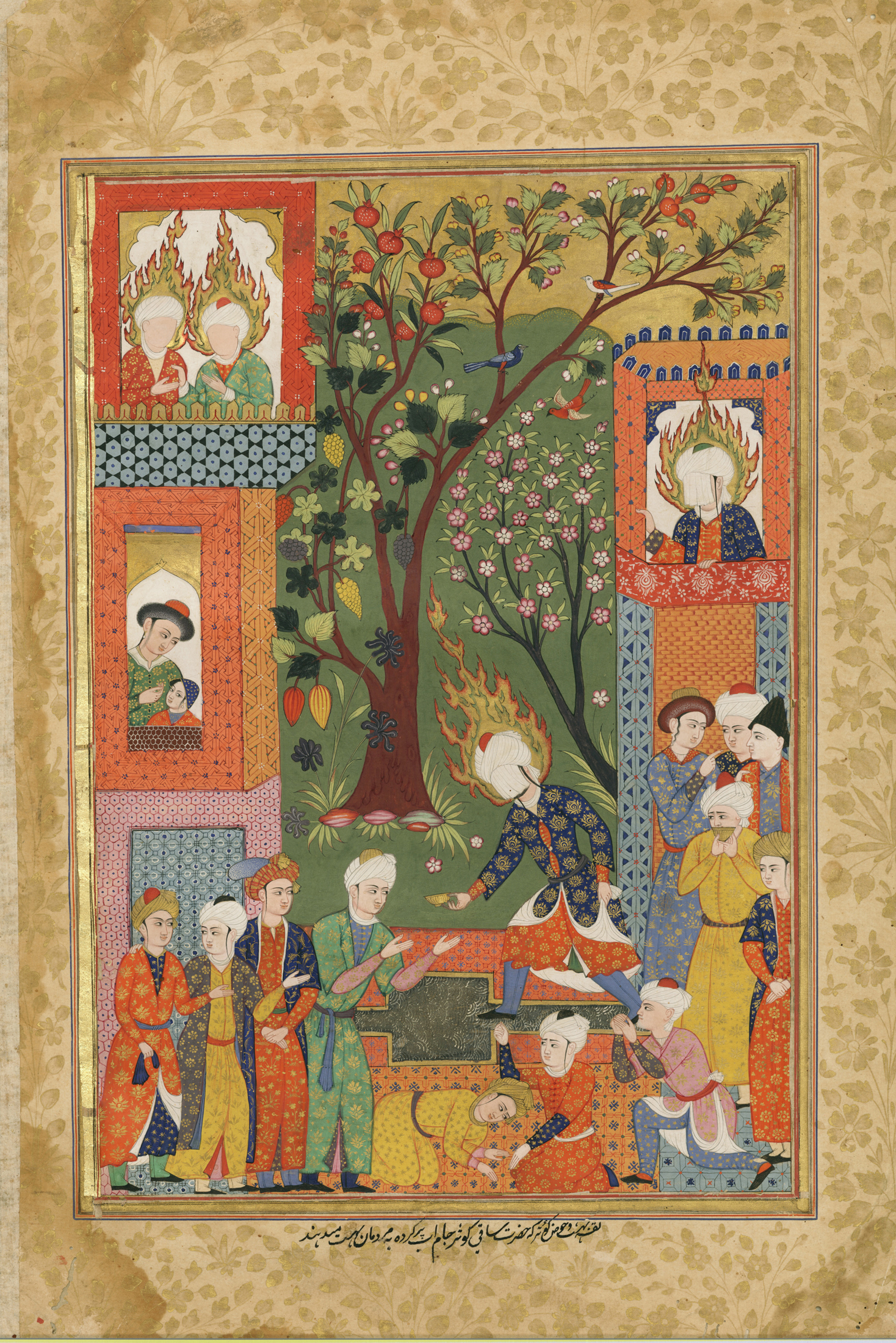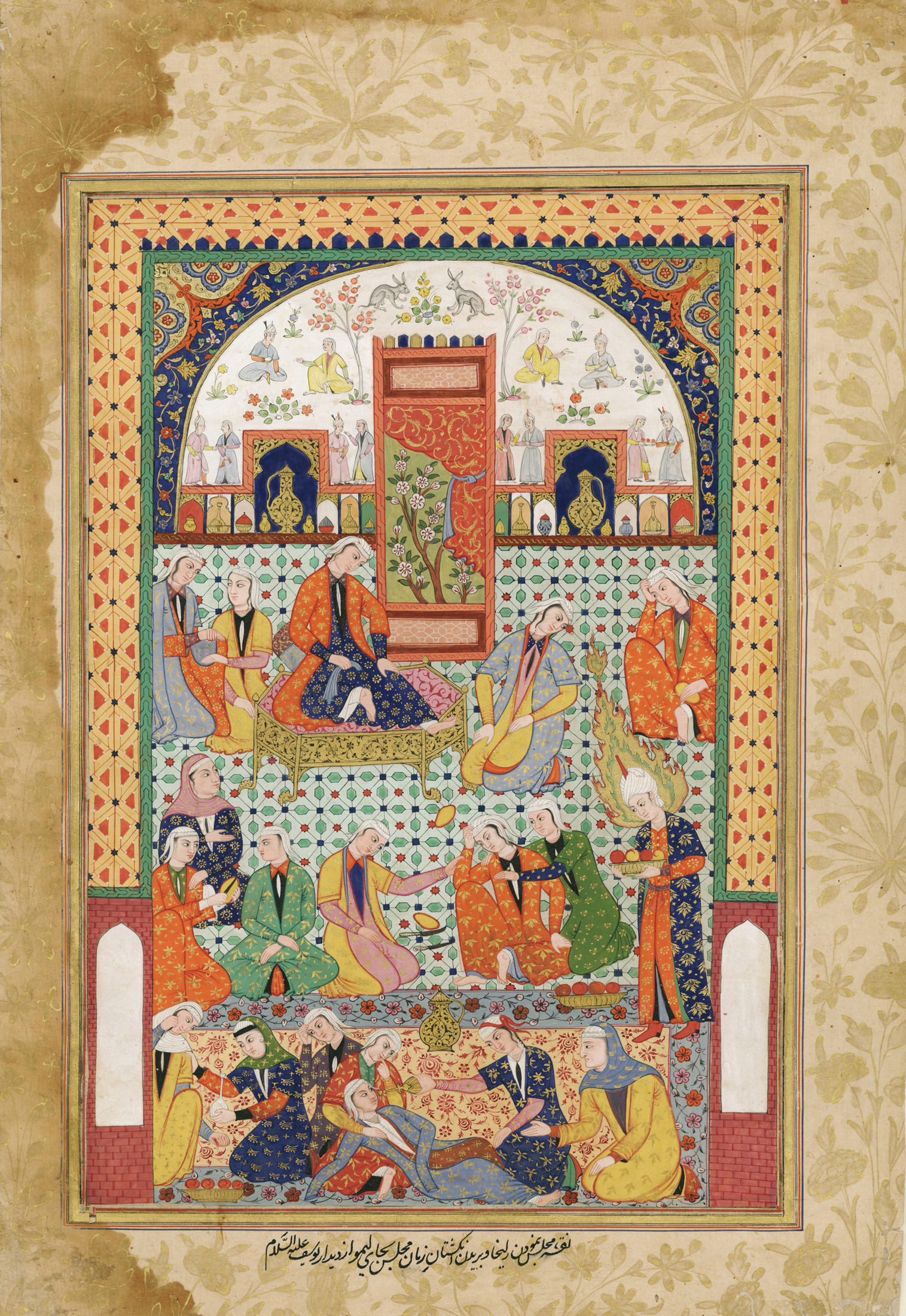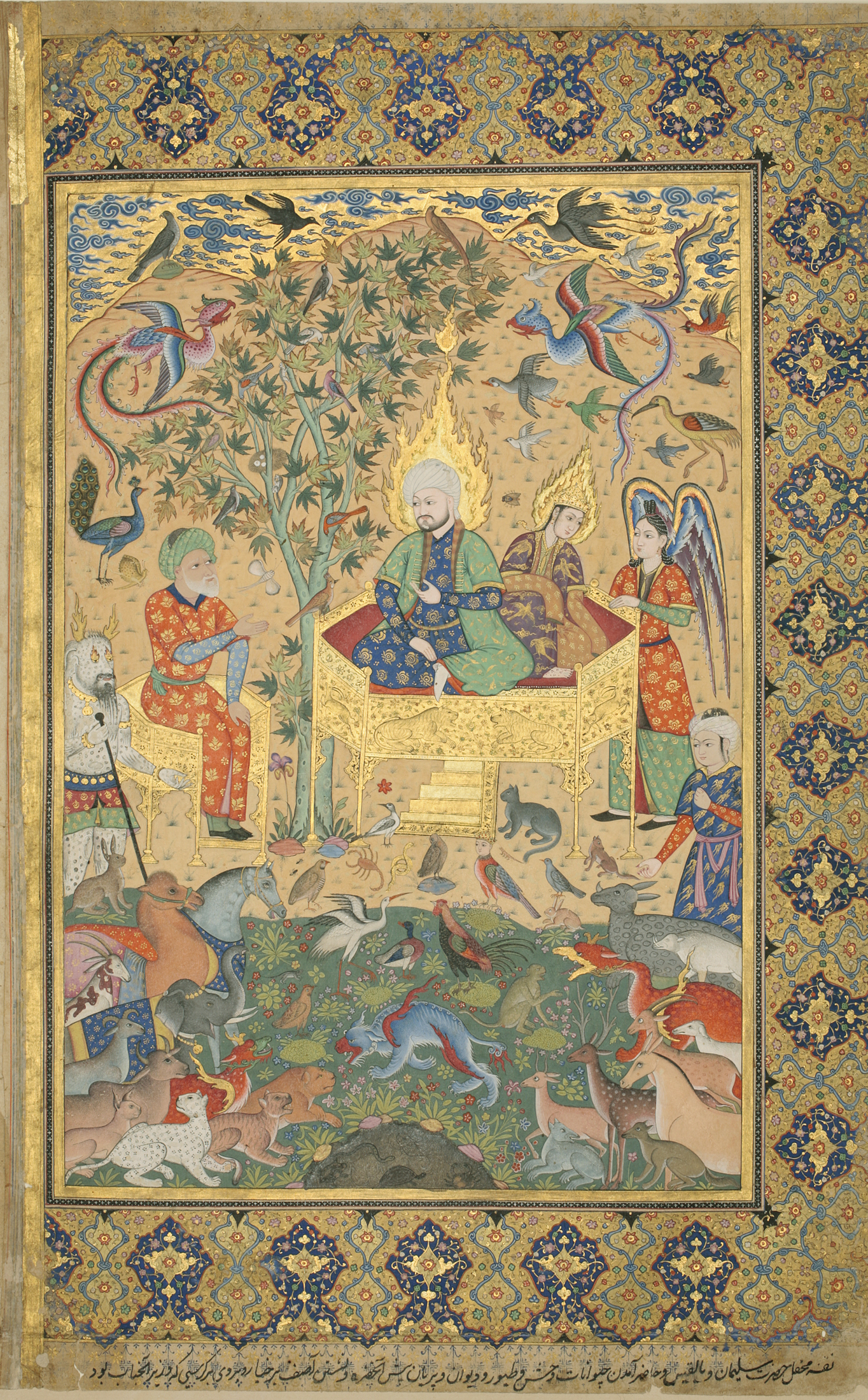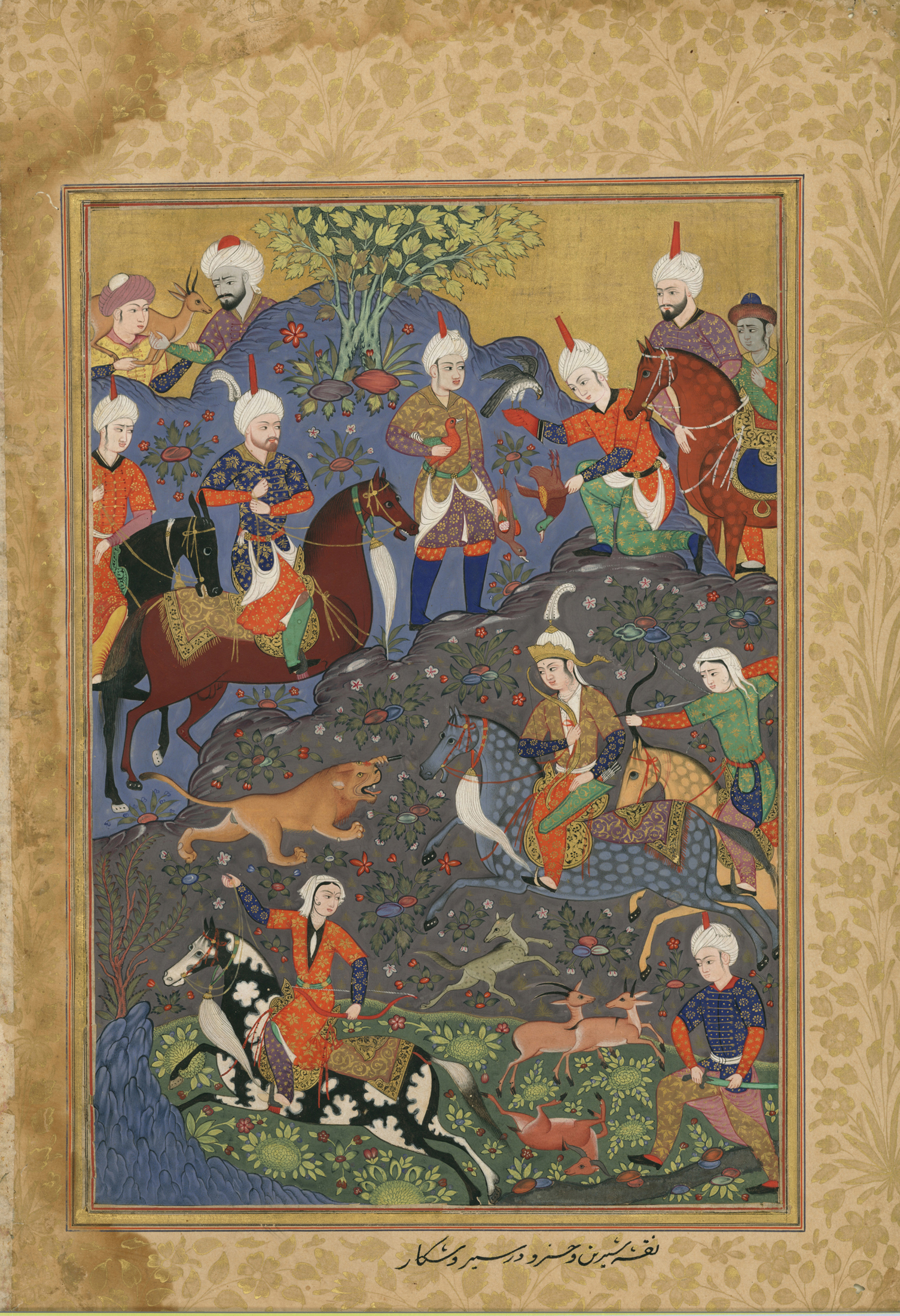 Print Page
Print Page
 Print Page
Print Page
Location: India, the Deccan, probably Golconda
Materials: ink, opaque watercolour, gold and silver on paper; 19th-century Indian binding of green leather with gold-tooled frames in a European manner
Dimensions: 41 x 28.4 cm (page); 30.5 x 21cm (text panels and paintings)
Accession Number: MSS 979
Other Notes:
This Falnamah (‘Book of Divination’) is one of the few complete – or near complete – copies of the work to have survived. It consists of a series of 35 double-page openings, each with a large miniature on the right-hand page (i.e., the verso). On the opposite page (the recto) is a caption for the painting and an explanation which predicts the outcome of the scene depicted in terms of delivering good, bad or variable fortune: if the prediction is unfavourable, the text recommends how to forestall it, delay a decision or buy one’s way out of it with a charitable donation. The first folio is the only one to have a painting on each of the recto and verso. That on the recot may possibly be the left-hand half of a double frontispiece. The text accompanying the painting on the last folio (36b) is missing.
The paintings can also be viewed for their own sake, for which purpose a second caption in Persian was added beneath each scene at a later date. The varied subjects include episodes from al-Kisa’i Qisas al-Anbiya’ (‘Tales of the Prophets’), an anthology of Christian, Jewish and Muslim legends; episodes from the life of the Prophet Muhammad; episodes from Nizami’s Khamsah; and depictions of miracle-working Sufis. Other illustrated Falnamahs suggest that they first became popular in Iran in the later 16th century and spread rapidly to Ottoman Turkey and to the Qutb Shahi court at Golconda.
The Illustrations
Folio 1a
The court of Najashi, king of Ethiopia
This is probably a left-hand half of a double frontispiece. The caption simply names the king, but offers no explanation for the scene depicted
Folio 1b
The meeting of Alexander and Plato
‘Alexander, accompanied by his army, meets Plato and receives an invitation to his dwelling’.
Folio 2b [see illustration]
Khidr giving cups of the water of immortality to the inhabitants of Paradise
‘The picture of Paradise and the pool of Kawthar, where his Holiness (i.e. Khidr), the cup-bearer, fills up the cups with water and gives them to the inhabitants of Paradise’.
Folio 3b
The death of Alexander
‘The picture of the dying Alexander and his court companions mourning his death’.
Folio 4b
Jesus fighting Dajjal, watched by Imam Mahdi
‘The picture of His Holiness Imam Mahdi – may peace be upon him, and Jesus – may peace be upon him, brandishing a spear at Khar-i Dajjal’(‘the deceiver’, and the Islamic archetype of the false prophet).
Folio 5b
Imam Riza ordering Zaynab devoured by lions
‘The picture of the lions eating Zaynab, the liar, by the order of Imam Riza – peace be upon him – at the court of the king’.
Folio 6b [see illustration]
Zulaykha’s friends cutting their fingers at the sight of Joseph
‘The picture of Zulaykha’s gathering and the ladies cutting their fingers instead of lemons on seeing Joseph – peace be upon him’.
Folio 7b
Isaiah bids the camel from the rock
‘The picture of His Holiness, the Prophet Isaiah – peace be upon him – and the appearance of the she-camel through his miracle, and the astonishment of the tribe’.
Folio 8b
The Prophet Muhammad visiting the Ka‘bah
‘The picture of Ka‘ba and the Prophet – peace be upon him – arriving for pilgrimage’.
Folio 9b [see illustration]
Khidr and Elias discovering the water of life, watched by Alexander
‘The picture of His Holiness Khidr, and Elias – peace be upon them – taking Alexander to the darkness, and finding the water of life’.
Folio 10b
The Day of Judgment
‘The picture of the Day of Resurrection, with the Sun on the spear, the passing of the creatures over the sirat [the sirat al-mustaqim, the narrow bridge over Hell], the falling of the sinners in Hell, the weighing of the Book of Deeds, the going of the pious ones to Heaven, the picture of Israfil with the trumpet, and the transformation of the faces of the criminals’.
Folio 11b
Jesus raising the dead
‘The picture of His Holiness Jesus – peace be upon him –bringing back to life the old woman’s baby in front of the king, and the amazement of those present, and her thanksgiving in front of His Holiness’.
Folio 12b [see illustration]
The Prophet Muhammad’s night ride (mi‘raj) on Buraq, and the Aqsa mosque
‘The picture of His Holiness [Muhammad] arriving on Buraq for Ascension at night, and the angels diffusing light for him, and the picture of the Aqsa Mosque’.
Folio 13b
Majnun fainting at the sight of Layla’s beauty
‘The picture of Layla coming out of the tent to preamble, being seen by Majnun who faints at the sight of her beauty, and the grieving of Layla’s companions at Majnun’s state’.
Folio 14b
‘Ali rescuing Salman Fars from the lion
‘The picture of His Holiness The Lion of God – peace be upon him – rescuing Salman Fars from the lion by the river, and Salman presenting a bunch of flowers to His Holiness’.
Folio 15b [see illustration]
The Prophet Muhammad sleeping on the lap of Abu Bakr while hidden in a cave
‘The picture of the Prophet – peace be upon him – hiding in the cave, and the spider making cobwebs, and the dove ... by the water, and His Holiness sleeping on Abu Bakr’s lap, and the snake stinging Abu Bakr’s foot, and the infidels arriving in search of that Holiness’.
Folio 16b
The Prophet Muhammad, his daughter Fatimah, ‘Ali, Hasan and Husayn
‘The picture of ‘The Five [holy] Ones’– blessings and peace be upon them’.
Folio 17b
Ahmad-i Jam riding a lion
‘The picture of Ahmad-i Jam, the Sufi’.
Folio 18b
The devotee Barsisa hanged for adultery
‘The picture of Barsisa, the devotee, who was hanged by order of the king on charges of adultery, and the reproaching devil coming with a ewer saying [sarcastically], “Pray now”, and taking his faith away’.
Folio 19b
Shaddad dying outside the gates of Paradise
‘Shaddad dying at the gates of heaven which he had built himself, and the arrival of the “king of death” to confiscate the soul of that cursed man, and the weeping of his companions’.
Folio 20b
‘Ali murdering Ghilman
‘The slaughter of Ghilman by Murtada ‘Ali – peace be upon him, by the order of the Prophet – the blessing of God be upon him – and the picture of the two Hasans – peace be upon them – and others’.
Folio 21b [see illustrations]
The beasts gathering before Solomon and Bilqis
‘The picture of the assembly of His Holiness Solomon and Bilqis (the Queen of Sheba), and the appearance of wild animals, birds, monsters, and fairies in front of that Holiness, and Asaf ibn Barkhiya who was the minister of that Holiness sitting on the opposite throne’.
The treatment of this spread differs form all the others: the margins of this and the facing folio are illuminated, and the text (folio 22a) is written within clouds reserved on gold-illuminated ground [see main illustration].
Folio 22b
Shah Tahmasp and his army in battle
‘The picture of Shah Tahmasp and his battle with his foe’s army’.
Folio 23b
Ya‘qub hearing about the supposed death of Joseph
‘The picture of His Holiness Jacob – peace be upon him – and the brothers losing Joseph – peace be upon him – and accusing the wolf of eating Joseph, and bringing the wolf in front of His Holiness, and the wolf denying it’.
Folio 24b [see illustration]
Karkhi, porter at the tomb of Imam Riza, being honoured
‘The picture of the holy sepulchre, and the coming of people for pilgrimage and kissing the famous hands of Karkhi, the porter [of the shrine]’.
Folio 25b
Mary and the infant Jesus visited by Zacharias and John
‘The picture of the birth of Jesus, and the arrival of His Holiness Zacharias and John – peace be upon them – and Her Holiness Mary apologizing in their presence, and others being astonished by the birth of a fatherless son’.
Folio 26b [see illustration]
The building of Noah’s ark
‘The picture of His Holiness Noah – peace be upon him – building the ark, and people preparing for it, bringing wood, carving planks, and that Holiness observing them’.
Folio 27b
The Prophet Muhammad preaching in Medina
‘The picture of the Prophet preaching at the pulpit, and other holy ones and angels appearing to hear him preach in the Illustrious Medina’.
Folio 28b
The death of John the Baptist
‘The picture of His Holiness John – peace be upon him – being slaughtered in the presence of the king who has gone astray’.
Folio 29b
Murra miraculously cut in half at Najaf
‘The picture of the Noble [city of] Najaf, and Murra going to the tomb of “the Commander of the Faithful” (i.e. ‘Ali) to commit some act of desecration, and the appearance of two fingers from his blessed tomb, and that repulsive person being sliced in half by the strike of the fingers of this blessed holy one’.
Folio 30b [see illustration]
The Queen of the peris in Paradise
‘The picture of the Garden of Paradise, and the Queen of the Fairies on her throne, being joyous and merry’.
Folio 31b
Pharoah with the infant Moses on his lap
‘The picture of Pharaoh with Moses – peace be upon him – sitting on his lap, and that Holiness stretching his arm towards La‘l, and his blessed hand falling in the fire, and the cursed Pharaoh becoming embarrassed’.
Folio 32b
The death of Khusraw Parviz
‘The sign of Shiruya tearing apart Khusraw Parviz’s belly, and people mourning his death’.
Folio 33b
The Prophet Zacharias discovered by his enemies hiding inside a tree
‘The picture of His Holiness Zacharias hiding in the tree out of fear of the clan, and the arrival of Satan with a saw, showing the tree to the clan’.
Folio 34b [see illustration]
‘Ali fighting at the gates of Khaybar
‘The picture of His Holiness Murtada ‘Ali – peace be upon him – pulling out the Khaybar gates and his fight with the infidels, and their assault from four sides on that Holiness, and that Holiness using the gate as a shield’.
Folio 35b [see illustration]
Shirin and Khusraw hunting
‘The picture of Shirin and Khusraw hunting’.
Folio 36b [see illustration]
Alexander asking a dervish for knowledge that will enable him to win a battle
‘The picture of Alexander going to the cave to see the dervish whose prayers are answered, and asking him for help in taking the fortress, and the dervish praying [for him]’.
Script:
text (on the rectos) copied in thulth and nasta‘liq scripts; 9 lines to the page; later captions in nasta‘liq
Bibliography:
L. York Leach, Paintings from India, The Nasser D. Khalili Collection of Islamic Art, volume VIII, London 1998, cat.65, pp.221–7.
J.M. Rogers, The Arts of Islam. Masterpieces from the Khalili Collection, London 2010, cat.316–26, pp.275–9.












